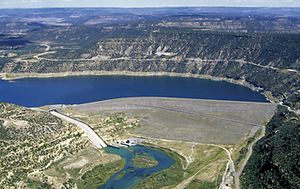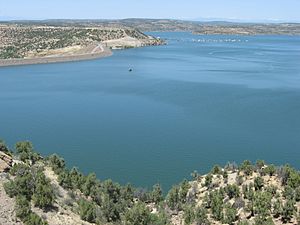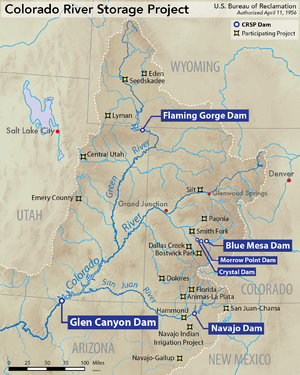Navajo Dam facts for kids
Quick facts for kids Navajo DamDaʼdeestłʼin |
|
|---|---|

View of Navajo Dam from the air
|
|
| Country | United States |
| Location | San Juan and Rio Arriba Counties, New Mexico |
| Coordinates | 36°48′01″N 107°36′45″W / 36.80028°N 107.61250°W |
| Construction began | July 30, 1958 |
| Opening date | April 20, 1963 |
| Owner(s) | U.S. Bureau of Reclamation |
| Dam and spillways | |
| Type of dam | Zoned earthfill embankment |
| Impounds | San Juan River |
| Height | 402 ft (123 m) |
| Length | 3,648 ft (1,112 m) |
| Dam volume | 26,840,863 cu yd (20,521,312 m3) |
| Spillway type | Concrete ungated chute |
| Spillway capacity | 34,000 cu ft/s (960 m3/s) |
| Reservoir | |
| Creates | Navajo Lake |
| Total capacity | 1,708,600 acre⋅ft (2.1075 km3) |
| Catchment area | 3,190 sq mi (8,300 km2) |
| Surface area | 15,610 acres (6,320 ha) |
| Power station | |
| Operator(s) | City of Farmington |
| Commission date | 1986 |
| Installed capacity | 32 MW |
| Annual generation | 135,226,000 KWh |
The Navajo Dam is a large dam in northwestern New Mexico, United States. It sits on the San Juan River, which flows into the Colorado River. This huge earthen dam is about 402-foot (123 m) tall. It is located in the foothills of the San Juan Mountains, about 44 miles (71 km) east of Farmington, New Mexico.
The U.S. Bureau of Reclamation built the dam in the 1960s. Its main jobs were to stop floods, provide water for farms, supply water for homes and industries, and store water during dry times. A small power plant was added in the 1980s to make electricity.
Navajo Dam is a key part of the Colorado River Storage Project. This big project helps manage water across the entire Upper Colorado River Basin. The lake behind the dam, called Navajo Lake, is a popular spot for fun activities. It is also one of the biggest bodies of water in New Mexico. Part of the lake even reaches into Colorado.
Contents
Navajo Dam is an earthfill dam. This means it is made from layers of different materials like rocks, gravel, sand, and clay. The dam is 402 feet (123 m) high and 3,648 feet (1,112 m) long. At its base, it is 2,566 feet (782 m) wide, and at the top, it is 30 feet (9.1 m) wide. The dam contains over 26,840,863 cubic yards (20,521,312 m3) of material. The very top of the dam is 6,108 feet (1,862 m) above sea level.
The dam creates Navajo Lake. This lake is one of the largest in both New Mexico and Colorado. It covers about 15,610 acres (6,320 ha) of surface water. Navajo Lake stretches for 35 miles (56 km) along the San Juan River. It also goes 13 miles (21 km) up the Los Pinos River and 4 miles (6.4 km) up the Piedra River. The lake can hold a lot of water, about 1,708,600 acre-feet (2.1075 km3). About 60% of this water can be used for different purposes.
How the Dam Manages Water
Before the dam was built, the San Juan River had very high water flows during spring snowmelt and summer rains. At other times, it was just a small stream. The dam now keeps the water flowing steadily all year. This helps with water supply, fun activities, and flood control.
The dam releases up to 1,320 cubic feet per second (37 m3/s) of water into the San Juan River. This water goes through a 32 megawatt hydroelectric plant. This plant is owned by the city of Farmington. The electricity made at Navajo Dam helps power about 37,000 homes and businesses in northwest New Mexico. Between 1989 and 1999, it made an average of 135,226,000 kilowatt hours of electricity each year.
If there are too many floodwaters, they can be released through a special tunnel. This tunnel can handle 4,200 cubic feet per second (120 m3/s) of water. There is also a concrete spillway that can release 34,000 cubic feet per second (960 m3/s). The spillway is 138 feet (42 m) wide at the top. It drops 410 feet (120 m) down a chute into a pool. Water released during floods should not go over 5,000 cubic feet per second (140 m3/s) to keep the river channel safe.
When the dam was first built, water releases were mainly for farming and flood control. But since the late 1990s, the rules have changed. Now, the dam also helps restore the environment of the San Juan River.
Navajo Dam is part of the federal Colorado River Storage Project (CRSP). This is a huge system of dams, lakes, and irrigation projects across the Upper Colorado River Basin. Navajo Dam is very important for making sure there is enough water for local users. It also provides water for the San Juan-Chama Project. This project moves water from the San Juan River to the Rio Grande valley, helping cities like Albuquerque, New Mexico.
The San Juan-Chama project uses up to 96,200 acre-feet (0.1187 km3) of water. This water would otherwise flow into Navajo Lake. A large amount of San Juan River water is also sent to the Navajo Indian Irrigation Project (NIIP). This project waters 70,000 acres (28,000 ha) of farmland south of the river. About 30% of Navajo Lake's water is set aside for the NIIP. Currently, the NIIP uses about 200,000 acre-feet (0.25 km3) of water each year. This amount is expected to grow as more farmland is developed. Both the San Juan-Chama and Navajo Irrigation Projects are part of the CRSP.
The idea for a dam on the San Juan River first came up in 1904. But at that time, the area was very remote, so there wasn't much need for it. In the 1920s, Farmington and nearby towns grew a lot because of farming and oil. This created a need for more water and better flood control. The San Juan River's flow changed a lot with the seasons, making both needs equally important.
The Navajo Nation's population was also growing. They faced shortages of food and jobs. The Bureau of Reclamation thought a big irrigation project could help solve these problems. A Supreme Court decision in 1908, called Winters v. United States, said that Native American reservations had a right to the water they needed for their homeland. This meant the Navajo people had rights to the San Juan River water, going back to when their reservation was created in 1868. This ruling eventually led to the Navajo Dam project. A 1955 report suggested a system to water 137,250 acres (55,540 ha) of new land on and near the Navajo Indian Reservation.
The plan for a large dam on the San Juan River became part of the Bureau of Reclamation's Colorado River Storage Project. Congress approved Navajo Dam on April 11, 1956. This law also approved Glen Canyon Dam and many other irrigation and power projects on rivers like the Green River and Gunnison River. The initial approval for Navajo Dam did not include the Navajo irrigation project. That project was approved later, in June 1962, along with the San Juan-Chama water diversion project.
Work at the Navajo Dam site began on October 8, 1956. This started with digging up old Native American sites along the river. However, these studies were limited, and only a few artifacts were saved. Some places important to the Navajo people were later flooded when the lake filled up. Other things that had to be moved or destroyed included the towns of Rosa and Los Arboles, several cemeteries, and parts of the Denver and Rio Grande Western Railroad. The main contract to build the dam was given to Morrison-Knudsen and other companies on June 25, 1958. Construction started a month later on July 30.
The first parts built were the water systems to move the San Juan River. The main tunnel to divert the river was finished on January 27, 1959. Another tunnel was finished on April 27, 1959. Concrete lining was done by October. The river was moved on January 4, 1960. This allowed work to begin on the main dam. More than 26,000,000 cubic yards (20,000,000 m3) of material was placed to form the dam. In August 1960 alone, a record 1,019,000 cubic yards (779,000 m3) was placed. As the dam grew taller, clearing the lake area began on June 30, 1961, and took about a year. The concrete spillway, west of the dam, was finished on September 15, 1961.
On June 27, 1962, the diversion tunnel was blocked. Water began to fill Navajo Lake for the first time. Navajo Lake was the first reservoir in the Colorado River Storage Project to start filling. The main dam was finished shortly after, on August 22, 1962. However, other parts of the project, like adding protective rock (riprap) and final concrete work, continued. The dam was officially opened on September 15, 1962, by Secretary of the Interior Stewart Udall. But it was not fully completed until April 20, 1963. The total cost of the Navajo Dam project was about $35 million.
After the dam was built in 1964, some cracks and small slides appeared. These were either fixed or settled on their own without major damage. The dam's sides and the spillway leaked a lot until the 1970s. Then, the Bureau of Reclamation fixed this by adding drainage systems and stabilizing material. The canals and tunnels for the Navajo Indian Irrigation Project started in 1966 and were finished on July 3, 1967. This allowed water to be delivered from Navajo Lake for farming. The main canal was fully completed in 1977. The Bureau of Indian Affairs then took over running the irrigation system. The lake did not fill completely until spring 1973, when water flowed over the spillway for the first time.
Also in 1973, the Bureau of Reclamation started planning a power plant at Navajo Dam. This plant was not part of the original design. Construction began in 1976. But it stopped when the National Wildlife Federation sued. They said that changing water releases for power could harm the environment. Because of this, Congress did not approve the project. However, in 1981, the city of Farmington asked for permission to build a private power plant at the dam. The Navajo Nation protested. They worried that if it was a private project, the Navajo people would lose potential benefits. In the end, the Navajo Nation and the city reached an agreement. The power plant was approved in 1986, and it started making electricity in 1989.
Navajo Dam has greatly changed the environment of the San Juan River. Before the dam, it was a warm, muddy river with very different flows throughout the year. Now, it is a cold-water stream with a fairly steady flow. The dam's effects are strongest in the 44 miles (71 km) stretch above Farmington. Further downstream, where the San Juan is joined by the Animas River, the dam seems to have had less effect on the river and its sediment.
Naturally, the San Juan River was home to native fish like Colorado pikeminnow, razorback sucker, and roundtail chub. But these fish have mostly disappeared. Now, the river has rainbow trout, non-native brown trout, and other fish that like cold water. These fish thrive in the cold water released from the bottom of Navajo Dam. The San Juan River is known as a "Blue Ribbon fishery." It is one of the most popular places for fly-fishing in the western United States.
In 1999, a program called the San Juan River Basin Recovery Implementation Program (SJRIP) was started. Its goal is to help native fish populations in the river recover. As part of this program, large amounts of water (5,000 cubic feet per second (140 m3/s)) are released from Navajo Dam in the spring. These high releases can last up to 60 days in wet years. But they might be stopped in dry years, depending on how much water is in the lake. Also, the low water flow during the dry season is reduced from 500 cubic feet per second (14 m3/s) to 250 cubic feet per second (7.1 m3/s).
These changes in water flow are meant to copy the natural high and low flows of the San Juan River before the dam was built. The high flows have been good for trout. However, the low flows are estimated to reduce trout habitat by 34%.



